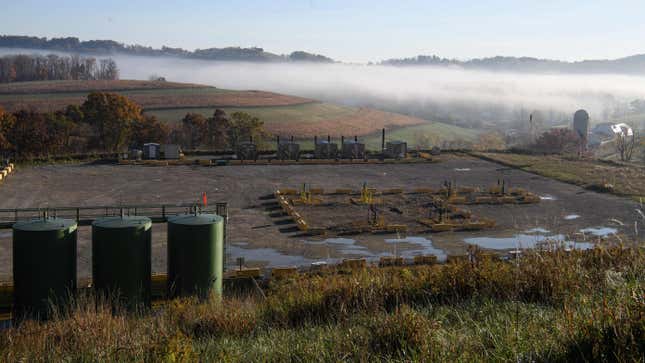
Climate experts and lawmakers often refer to the social cost of carbon, which is an approximate cost of the net harm caused per ton of carbon dioxide dumped in the atmosphere. A new study, published in Nature on Wednesday, looks at the social cost of a different greenhouse gas: methane. The findings show that the cost is higher than carbon—and wildly different around the world because of rampant economic inequality.
Methane is a powerful greenhouse gas that is 80 times more potent than carbon dioxide in the short term. Some 60% of methane released into the atmosphere comes from industry, including flaring from oil and gas extraction and animal agriculture. Scientists recently revealed that there’s more of the toxic stuff in the atmosphere now than at any point in recorded history. Understanding the damage it’s doing is more vital than ever.
The authors used a standard method used by the International Monetary Fund to estimate the price society pays to deal with methane emissions, factoring in the climate impacts the gas causes. They did so using four different climate models, and found that the average global social cost of emitting a metric ton of methane is $933 under a high-emissions scenario. That’s 22% lower than the mean cost calculated by the U.S. under the Obama administration, which is the estimate being used by the Biden administration today.
“We’re suggesting they slightly overestimated it,” William Collins, an earth and planetary scientist at the University of California Berkeley’s Lawrence Berkeley National Laboratory who was one of the study’s co-authors, said in a statement.
But the authors say that $933 isn’t really a fair price. In reality, each metric ton of methane emitted causes more suffering for low-income regions relative to wealthy ones. That’s because though poorer countries in the Global South are by and large the least responsible for the climate crisis, they disproportionately bare the brunt of rising sea levels, lowered agricultural productivity, and damaging extreme weather events. These disasters are also more difficult to weather in countries with fewer resources and will have an outsize economic impact compared to wealthy countries.
To account for this, the authors employed an approach known as equity weighting. It modifies the price of greenhouse gas emissions by weighting damages in low-income countries more heavily than damage affecting richer ones.
“The impacts of climate change on human welfare are typically expressed in dollars. The question is how to add dollars? The conventional approach is to simply add them up,” Richard Tol, a professor of economics at the University of Sussex who did not work on the study but has studied the social cost of greenhouse gas emissions, said in an email. “This, however, assumes that a dollar is worth the same to a woman in Baltimore as it is to a woman in Bengaluru. Equity weights correct for that. The equity weight equals the value of a dollar to a poor woman relative to the value of a dollar to a rich woman.”
Under this framework, methane emissions come with a different price depending on what country is producing them. The cost, the authors found, jumped up by almost a factor of 10 for rich nations and down by almost a factor of ten for poor ones, because countries in poor nations should be expected to pay far less for methane reduction.
For instance, the price decreased to $130 per metric ton for sub-Saharan Africa and rose to $8,040 per metric ton for the U.S. Those numbers reflect how much residents of each country would sacrifice in well-being to cut each metric ton of methane produced. Importantly, policies with those different price tags in each nation would produce the same climate benefit for the world at-large.
The study comes after President Biden signed an executive order creating a working group to provide accurate numbers on the social costs of carbon, methane, and nitrous oxide within a year. The authors hope their findings can inform these discussions.
“The Biden administration’s climate policy agenda calls for prioritizing environmental justice and equity,” said Frank Errickson, a postdoctoral fellow in climate economics at Princeton University, in a statement. “We provide a way for them to directly incorporate concerns for equity in methane emission regulations.”
Importantly, the damages caused by each extra ton of methane will differ depending on the total amount of greenhouse gases emitted. If the world makes an effort to draw down overall climate pollution, each individual ton is less harmful. For instance, in a scenario where the world enacts serious climate policies that start to rapidly draw down greenhouse gas emissions in the next decade, the cost of methane pollution would go down by 24% per metric ton.
“If we choose mitigate climate change more aggressively, the social cost of methane drops drastically,” said Collins. In case we needed another reason to urgently take on the climate crisis.